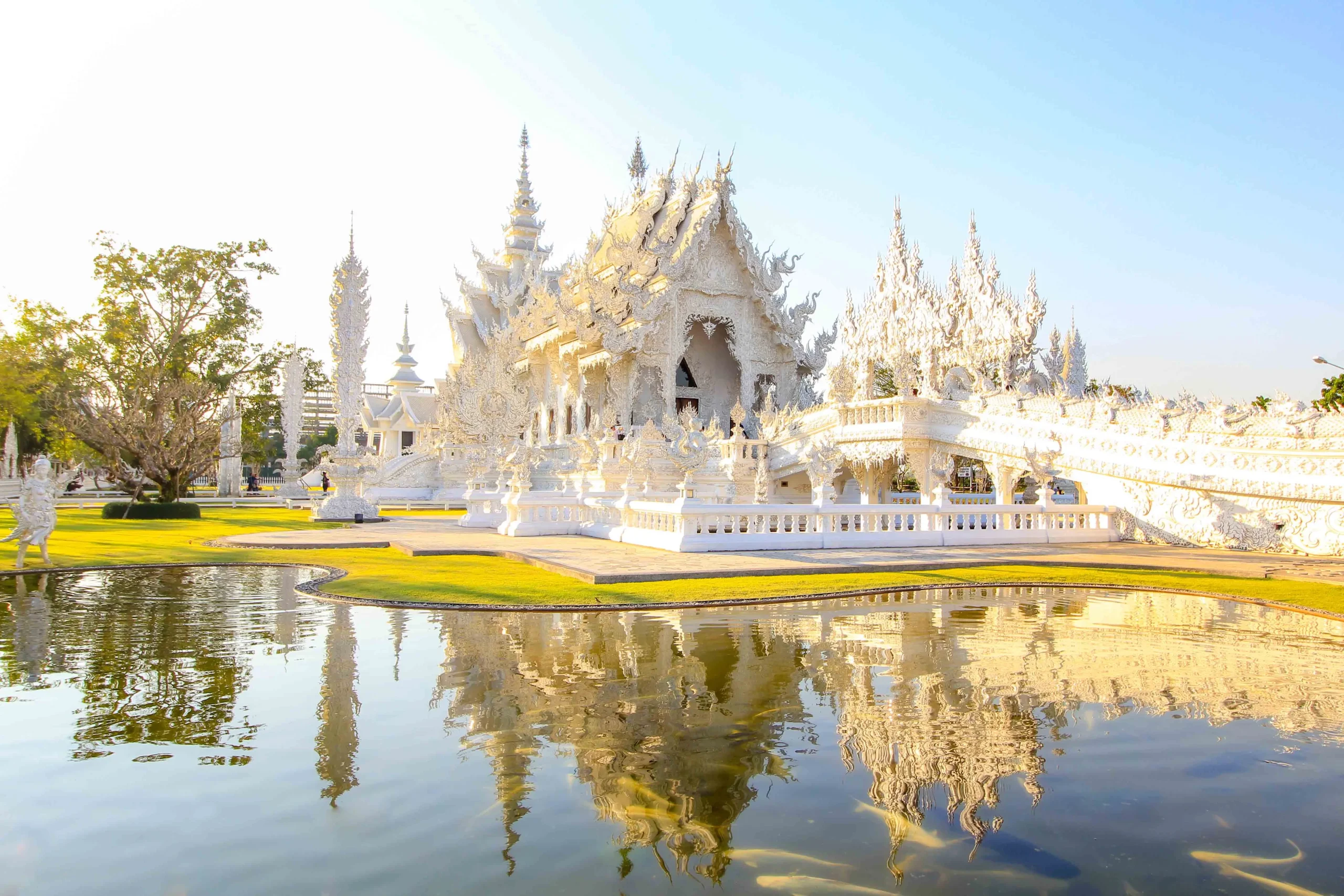Stepping into the grounds of Wat Rong Khun, the iconic White Temple Thailand, feels like entering a dream. Nestled in the heart of northern Thailand, this remarkable White Temple Thailand isn’t just a place of worship—it’s a masterpiece that fuses traditional Buddhist teachings with contemporary art. As you approach, the dazzling white structure stands in stark contrast to the vivid blue sky, its reflective surfaces glittering in the sunlight. The temple’s supernatural beauty is not just skin deep; every element of its design is steeped in symbolism, representing the journey of life, death, and rebirth. Whether you’re a spiritual seeker or an admirer of art, Wat Rong Khun, the White Temple in Thailand, promises an experience that surpasses the ordinary.
The Mastermind Behind The White Temple in Thailand
The story of Wat Rong Khun, or the White Temple Chiang Rai Thailand, begins with a visionary artist named Chalermchai Kositpipat. Born in Chiang Rai, Chalermchai was driven by a passion for Buddhist art from a young age. His dream? To create a temple that would reflect the purity of Buddha’s teachings while showcasing the beauty of Thai culture. In 1997, with no government funding and limited resources, Chalermchai embarked on an ambitious project to rebuild the old Wat Rong Khun into a symbol of spiritual enlightenment. His dedication was nothing short of extraordinary—he poured his own money, time, and energy into the temple, considering it his life’s work. Today, Wat Rong Khun white temple stands as proof of Chalermchai’s unwavering commitment, attracting visitors from all corners of the globe.
Where is Wat Rong Khun Temple Located?
Wat Rong Khun, also known as the Thailand White Temple, is situated about 13 kilometers south of Chiang Rai, a small city in northern Thailand. This serene location is easily accessible from the city center, making it a popular day trip for both domestic and international tourists. The easiest way to reach the temple is by taking a taxi or a songthaew (a shared red truck). The journey takes about 20 minutes, offering a scenic drive through lush landscapes and rural villages. As you get closer, the temple’s dazzling white shape emerges on the horizon, drawing you in like a lighthouse.
Discover the Majestic Beauty of Wat Rong Khun
The Magnificent White Color Against the Deep Blue Sky
The first thing that strikes you about wat rong Khun Chiang Rai Thailand, is its pristine white color. This choice of color is not merely aesthetic; it represents the purity of Buddha and the path to enlightenment. Against the backdrop of the deep blue Thai sky, the temple looks almost otherworldly, like a snow-covered palace in a tropical land. The white structure is decorated with countless tiny mirrors that catch the sunlight, creating a dazzling effect that enhances the temple’s supernatural aura. As you walk closer, you can see the intricate details in the carvings—each telling a story of the Buddhist philosophy.
The “Cycle of Rebirth” Bridge
As you approach the entrance, you’ll come across the “Cycle of Rebirth” Bridge—a striking feature that is both beautiful and symbolic. The bridge is flanked by hundreds of outstretched hands reaching up from the underworld, representing human desires and suffering. Walking across this bridge is meant to symbolize the crossing from the cycle of rebirth into the state of enlightenment. The experience is both mysterious and awe-inspiring, as you are reminded of the temporary nature of life and the importance of overcoming earthly attractions.
The Gate of Heaven
After crossing the bridge, you are welcomed by the “Gate of Heaven.” Guarded by two fierce, larger-than-life creatures, this gate marks the transition from the earthly realm to the divine. The creatures are known as Rahu and Death, representing fear and suffering, and they serve as protectors of the temple, ensuring that only those pure of heart can proceed. The gate itself is an architectural marvel with detailed carvings that depict the divine realm. Passing through this gate feels like stepping into another world, one where peace and serenity rule.
Ubosot – The Most Important Building of Wat Rong Khun
The Ubosot is the main building of Wat Rong Khun and the heart of the temple complex. This dazzling white structure is decorated with reflective glass tiles, which shimmer in the sunlight. The exterior is an artistic representation of the divine, with detailed carvings and statues that depict various scenes from Buddhist scriptures. Inside, the walls are adorned with murals that tell the story of Buddha’s life, from his birth to his enlightenment. A golden mural of Buddha graces the interior, giving off a sense of peace and faith. The Ubosot is a place of deep spiritual significance where visitors can reflect on the teachings of Buddha and find inner peace.
The Ganesha Worship Hall
One of the newest additions to Wat Rong Khun is the Ganesha Worship Hall, which is set in a peaceful pond. This beautiful structure is dedicated to Ganesha, the Hindu god of wisdom and success, known as Phra Phikanet in Thailand. The hall’s design is a blend of traditional Thai and contemporary styles, with a statue of Ganesha at its center. The serene surroundings of the pond, coupled with the hall’s elegant design, create a peaceful atmosphere, making it a perfect spot for quiet contemplation.
The Golden Building
In contrast to the white temple, the Golden Building stands out with its striking golden hue. This building is not just a restroom; it’s an architectural masterpiece in its own right. The golden color symbolizes the body, in contrast to the white temple, which represents the mind. The complex details of the building’s design are a testament to the skill and creativity of the artisans who built it. Visitors often find themselves captivated by its beauty, making it one of the most photographed spots in the temple complex.
The Museums and Galleries
Wat Rong Khun also houses several museums and galleries, which are extensions of Chalermchai Kositpipat’s vision. These spaces showcase a wide range of art, from traditional Thai paintings to contemporary works. The museum offers insight into the artist’s creative process and the evolution of his work over the years. It’s a fascinating journey through the mind of a visionary, providing visitors with a deeper understanding of the cultural and spiritual significance of the White Temple Thailand.
Facts about Wat Rong Khun
- Wat Rong Khun, the White Temple Chiang Rai Thailand, is privately owned by Chalermchai Kositpipat, who sees it as his gift to Buddha.
- The construction of Wat Rong Khun began in 1997 and is still ongoing, with plans to complete it by 2070.
- The temple’s design incorporates elements of both traditional Thai architecture and modern art, reflecting the fusion of old and new.
- Wat Rong Khun was heavily damaged by an earthquake in 2014, but Chalermchai decided to restore it completely, viewing it as an opportunity to make the temple even more beautiful.
Visitor Tips
- Best Time to Visit: The ideal time to visit Wat Rong Khun, the Thailand White Temple, is early in the morning or late in the afternoon to avoid the midday heat and crowds. The temple is open from 8:00 AM to 5:00 PM.
- Dress Code: Visitors should dress modestly, covering their shoulders and knees as a sign of respect.
- Behavior Guidelines: As Wat Rong Khun is a place of worship, it’s important to maintain quiet and respectful behavior while on the temple grounds. Photography is allowed, but avoid taking selfies in front of the Buddha statues.
Nearby Attractions
While in the area, consider visiting some of the nearby attractions:
- Baan Dam Museum (Black House): A unique museum that contrasts with Wat Rong Khun, showcasing dark and mysterious art.
- Singha Park: A beautiful park perfect for a relaxing stroll or a cycling tour.
- Chiang Rai Night Bazaar: A vibrant market offering local crafts, food, and live entertainment.
At The End
Wat Rong Khun is more than just a temple; it’s a living canvas, a place where art and spirituality merge to create something truly extraordinary. Whether you’re drawn by its beauty, its cultural significance, or its deep spiritual meanings, a visit to this iconic White Temple Thailand is sure to leave you inspired. As you leave, you’ll carry with you not just memories of its stunning architecture but also the profound messages embedded in every corner of this incredible masterpiece.
FAQ’s
Wat Rong Khun symbolizes the path to enlightenment, blending Buddhist teachings with contemporary art to represent purity, life, death, and rebirth.
Absolutely, Wat Rong Khun is a unique and visually stunning temple, offering a profound blend of art, spirituality, and cultural insight.
The outstretched hands at Wat Rong Khun symbolize human desires and suffering, representing the cycle of rebirth and the path to enlightenment.
The “White Temple of Death” refers to symbolic elements in Wat Rong Khun that depict the consequences of human sins and the journey towards spiritual purity.
Wat Rong Khun is privately owned by Chalermchai Kositpipat, the visionary Thai artist who designed and financed its construction.

